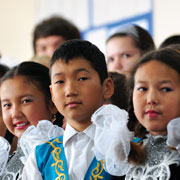Human capital
Education and human capital in transition and SEMED countries
- Details
- Human capital
At the beginning of the transition process the stock of human capital in the former communist economies was equivalent to – and even above – that in most advanced economies. The proportion of the population aged 25 and over that had completed at least secondary education stood at 36.6 per cent in 1990, compared with 34.9 per cent in advanced economies (see Chart 4.1a).1 In 2010 the figures were 51.8 per cent and 49.4 per cent respectively.
However, countries in the transition region lag behind at tertiary level. In 1990, 8.1 per cent of the population had completed tertiary education, compared with 10.3 per cent in advanced economies (see Chart 4.1b). The gap had widened by 2010, with figures of 11.0 per cent and 16.6 per cent respectively. Nevertheless, several countries ‒ Estonia, Lithuania, Russia and Ukraine – are now close to or above the average for advanced economies. The transition region as a whole is also significantly ahead of the SEMED countries and other emerging market and developing economies.
On the basis of educational attainment data of this type, many governments and international organisations assumed after the collapse of communism that transition to a market economy would be “promoted by a valuable and transferable stock of human capital”.2 However, some observers warned that there was a significant gap between technical and business-related skills.3 It was nevertheless hoped that the gap could be closed quickly, at least in some countries, by providing and improving higher education in “key subjects such as economics, administration, and Western languages”.4
However, several researchers found evidence suggesting that the skills of older cohorts of educated workers depreciated significantly after the start of the transition process, and that their productivity and wages did not increase.5 More recently, concerns about the quality of management skills have emerged from surveys6 and annual census-type data.7 In addition, large-scale brain drain has deprived a number of countries of skilled workers. The fact that in some countries migrant remittances account for more than 10 per cent of GDP illustrates the scale of the problem.8
Such findings suggest that focusing on educational attainment is not enough. Building a stock of human capital that will promote development requires an emphasis on the quality – rather than just the quantity – of education.9
- See Barro and Lee (2013). Advanced economies consist of high-income countries according to the World Bank’s July 2013 classification, excluding transition countries. [back]
- See Kertesi and Köllő (2002). [back]
- See Kertesi and Köllő (2002). [back]
- See Svejnar (1990). [back]
- See Kertesi and Köllő (2002), Rutkowski (1996), Puhani (1997), Večerník (1995), Flanagan (1995), Chase (1998), Krueger and Pischke (1995), Burda and Schmidt (1997) and Guriev and Zhuravskaya (2009). [back]
- See Bloom et al. (2012) and Schweiger and Friebel (2013). [back]
- See Brown et al. (2006).[back]
- According to the World Bank (2011), Tajikistan (47%), the Kyrgyz Republic (29%), Moldova (23%), Armenia (13%), Jordan (12%) and Bosnia and Herzegovina (11%) were among the countries with the largest remittance inflows as a share of GDP in 2011. [back]
- See Pritchett (2001). [back]













